
Do you know where your best customers come from?
Have you ever even really thought about that question?
If your business is 100% e-commerce, then it would be easy to run a few reports in Google Analytics and figure out which Acquisition/Channel brings the most visitors. You could also use the Conversions/Attribution to see when people first discovered you and what eventually turned them into buyers.
Retail stores have a more difficult time knowing how customers found them and what got the customer to walk into the store. It would be great if you could ask the customer how they found out about you, but many times you get simple answers like "a friend" or "the newspaper" or "Google."
Referrals are always good. An existing happy customer told this new customer to visit. That's a win, and it would be great if that happy customer wrote an online review too.
If they mention your newspaper or other offline ad, then you can usually attribute their visit to the most recent ad. They probably saw other offline ads, but it was the most recent ad that finally convinced them to come in. Most local newspaper ads help to build a brand over the longterm.
You certainly don't want to put your customer under a microscope, but saying they found you through Google isn't really helpful for understanding how they found you. They might have seen your Facebook post in Google, they might have seen a Yelp review, they might have seen your AdWords ad, or maybe they actually saw your website. The problem is that you simply don't know. And they don't remember.
In order to figure out the source for your most valuable customers, you can start with running some reports to see the number of customers you have in all your local towns and the average sale value for the people living in those towns.
The next thing to do is figure out which of your ads reached all those towns. Do you buy print ads for different mailing routes? What are the target towns for your newspaper ads?
You can also take a look at the Location report in Google Analytics ( Audience -> Geo -> Location ) to see where people are when they click on your website.
When you match up this geo-information, you might be able to figure out which of your ads are reaching certain audiences.
But understanding the geo-information isn't enough. You also need to look at how social media affects your sales; except without an e-commerce site, you really have no direct way to tie your sales to our online activity. On the other hand, we do have the ability to make a few guesses.
Take a look at your Network Referrals report by clicking on the Google Analytics navigation shown here:
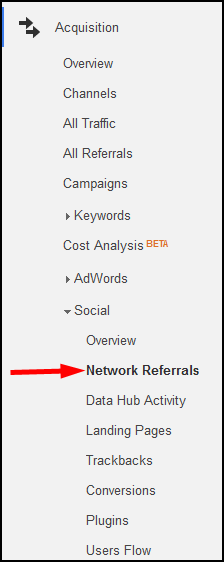
You will see a report like this one that shows all the social networks Google analytics is tracking.
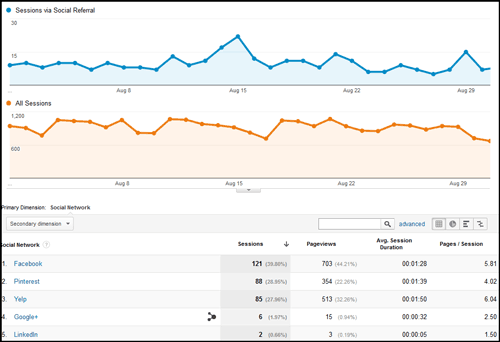
The screen shot above shows 121 people arriving from Facebook over the last 30 days. But it would be good to know how many of them came from each of the specific towns that correspond to our highest average sale values.
We can format our report to show specific towns, but we do need to jump through a few hoops to correctly format our filters before we can see the report. First, on the left navigation you need to click on the Location report shown here:
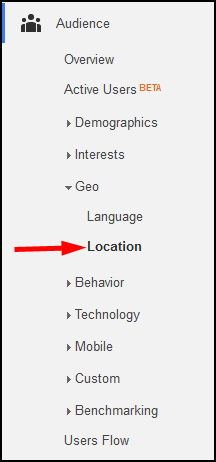
After clicking that navigation link, you'll see a map of the world. Click on your country and then your province/state until you get within your local area. For my home state of New Jersey it looks like this:
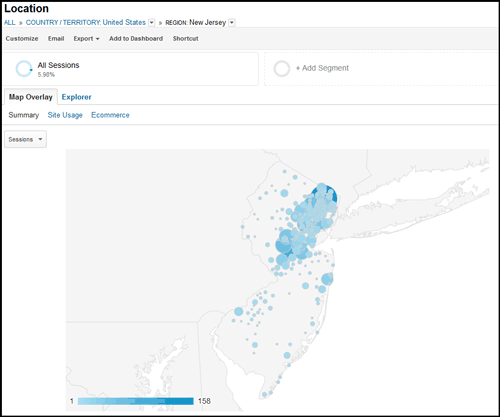
Scroll down a little on that map report to see the actual town names that that associate with all those large blue circles you see above. Here's a list of the towns I see:
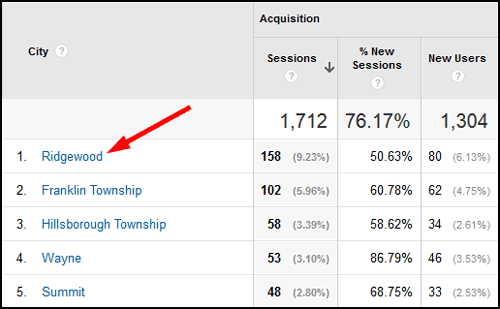
I'm clicking on my first town name of Ridgewood, but you would want to click on the town name associated with your highest average sales value.
For this next step, I need to refer back to a previous Nugget that explains how to set up a new segment. Click here and refer to the section titled "Setting Up the Segment" before continuing.
Now I want you to create a segment for your single town, in my case that's going to be Ridgewood. To do this, you will click on the +Add Segment button at the top of the screen and then click on the red +New Segment button to reveal this screen:
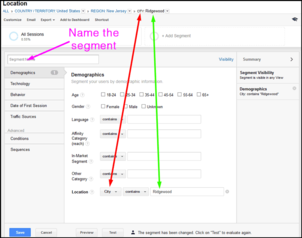
(click to enlarge)
We're going to create a segment according to the Location and the City, so change the Location drop down to City and then type in the town name you want to select. The red and green arrows in the above screen shot will direct you to the correct settings.
You need to name the segment before clicking the blue Save button. I suggest naming the segment after your town. Once saved, you will see your specific town segment at the top of your screen like this:

The last step is to go back to the Network Referrals report to see how many people from that town were referred to you from the specific social networks. Here's what mine looks like:
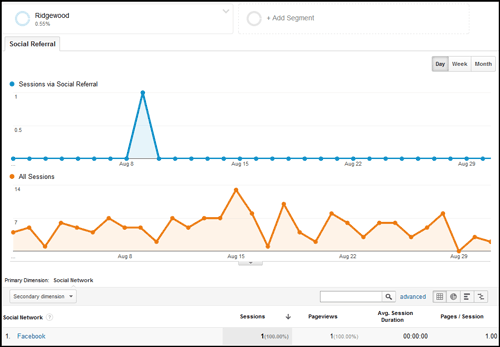
With the segment applied, I now see that only one person from Ridgewood came to the website from Facebook. Notice that no other social networks were reported for Ridgewood either.
You'd have to repeat this exercise for each of the towns you want to evaluate.
There are several different ways to organize and evaluate this information into something useful. You should always post to your social networks whenever you have offline advertising. That approach will help you reach your online and offline customers at the same time with the same message. You'll also be able to report on the different traction between the social posts and the offline ads.
By the way, you can usually measure the traction of your offline ads by looking at the number of people who arrived on your site as "Direct Traffic." There's a built-in segment for Direct Traffic that you'll find when clicking the +Add Segment button at the top of the screen.
Mixing and matching the segments will allow you to see when people were referred from the social networks. You can then compare what you posted during those days.
By the way, the typical retail store report will have very low numbers in all these reports. It's best for you to analyze these numbers over a 6 month or more period. Make sure to have the dates in Google Analytics correspond to the sales reports you printed from your post of sale software.
After you review all this data, you'll have a better understanding of which towns to concentrate more of your advertising, and you'll even have a better idea of where to spend your online advertising budget to reach people in certain towns through Facebook.
The bottom line is that customer tracking information is really good to help you understand if you are wisely spending your money and where you can better direct your advertising efforts.








